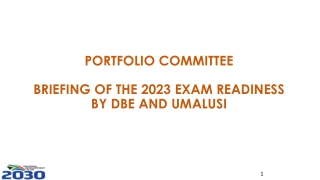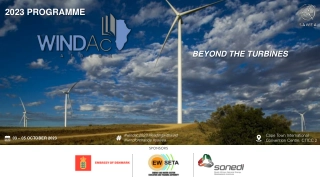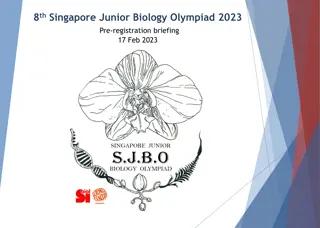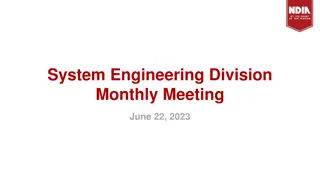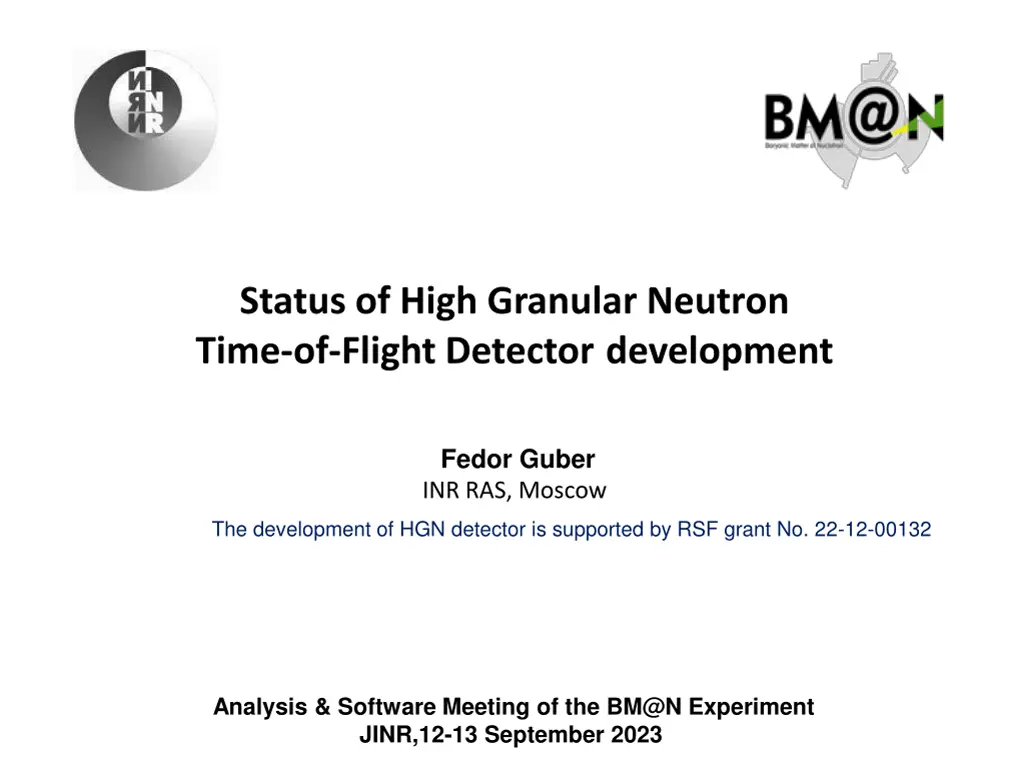
Development of High Granular Neutron Time-of-Flight Detector
Learn about the progress in the development of the High Granular Neutron Time-of-Flight Detector at Fedor Guber's lab in Moscow. Supported by RSF grant, the detector's structure, components, simulation results, and future plans are detailed in this informative update. Explore the proposed detector setup, the selection of components, and the positioning at the BM@N experiment, along with insights into its efficiency, energy resolution, and neutron yields. Discover the specifics of the neutron detector's structure, featuring SiPM readout and scintillator layers, and delve into measurements of time resolution and detector positioning constraints. Follow the developments through Monte Carlo simulations of neutron reactions to gain a comprehensive understanding of this cutting-edge technology.
Download Presentation

Please find below an Image/Link to download the presentation.
The content on the website is provided AS IS for your information and personal use only. It may not be sold, licensed, or shared on other websites without obtaining consent from the author. If you encounter any issues during the download, it is possible that the publisher has removed the file from their server.
You are allowed to download the files provided on this website for personal or commercial use, subject to the condition that they are used lawfully. All files are the property of their respective owners.
The content on the website is provided AS IS for your information and personal use only. It may not be sold, licensed, or shared on other websites without obtaining consent from the author.
E N D
Presentation Transcript
Status of High Granular Neutron Time-of-Flight Detector development Fedor Guber INR RAS, Moscow The development of HGN detector is supported by RSF grant No. 22-12-00132 Analysis & Software Meeting of the BM@N Experiment JINR,12-13 September 2023
Outline: Proposed structure of the High Granular Neutron (HGN) detector. Selection of components for the HGN active detectors. HGN detector position at the BM@N. Results of simulation of the HGN detector acceptance, efficiency, energy resolution and yields for neutrons from reaction BiBi@3.0AGeV. Status of the HGN detector development. Future plans. 2
Structure of neutron detector for the BM@N: High Granular Neutron (HGN) time-of-flight detector with SiPM readout 15 layers (Cu/Scint) Structure of Scint. layer: array of 11x11 scintillator cells 4 x 4 cm2 44cm 44cm Veto Cu Scint - Transverse size of one layer: 44 x 44 cm2, - number of layers: 15 + Veto, - structure of layer: - 3 cm Cu (absorber) + 2.5cm Scint. + 0.5cm (SiPM+FEE) - size of scintillation detectors (cells): 4x4x2.5 cm3, - total number of cells: 1936 - light readout: one SiPM with sensitive are 6 x 6 mm2per cell - total length of the HGN: ~ 95 cm (~3 in) 3
Measurements of time resolution of scintillation detectors (scint + SiPM) F.Guber et.al., Instruments and Experimental Techniques, 2023, Vol. 66, No. 4, pp. 553 557 (JINR. scint. + Hamamatsu, SensL photodetectors) F.Guber et.al., arXiv:2309.03614v1 [hep-ex] 7 Sep 2023 (JINR, EJ230 scint. + EQR photodetector) Photodetector: EQR15 11-6060D-S (sensitive area - 6x6 mm2, 15mkm pixel pitch, 160 000 pixels, PDE - 45%, gain - 4 105) Test results on e-beam at LPI Scintillator: 1) JINR produced (40 40x25mm3), 1.5% paraterphenyl and 0.01% POPOP) with light time decay of 3.9 0.7 ns ~117 ps, N ph.el. = 158 9 ~ 74 ps, N ph.el. = 292 2 2) EJ230 with light time decay of 2.8 0.5 ns JINR scintillators will be used for the HGN detector because they are available and significantly cheaper than EJ230. FEE: LMH6629MF preamp (20 dB gain, bandwidth of 600 MHz at a 3 dB level, and noise of <2.2 nV/ Hz) + rapid discriminator (ADCMP553) with a fixed threshold. 4 Readout: CAEN DT5742
Positions of neutron detector at the BM@N 21 2 There are some constrains to install neutron detector on the BM@N: - angle range 17 23 degrees, - Distance from the target 500 cm. - Detector length ~ 1 m. 5
Monte Carlo simulation of the HGN detector Bi + Bi reaction at 3.0 AGeV. DCM-QGSM-SMM event generator (106minimum bias events). GEANT4 was used for particles propagation through the BM@N and the HGN detector in the BmnRoot software framework. The HGN detector positioned at angle 17 degrees on the distance 500 cm from the target. 6
Dependence of neutrons time-of-flight on the entrance of the HGN detector on its kinetic energy - At neutron time-of-flight cut < 25 ns the number of background neutrons will be reduced as factor of 6. - At this time cut only primary neutrons with kinetic energy more than about 300 MeV will be analyzed. 7
Acceptance of the HGN detector (with cut on neutron time of flight < 25ns) Y0= 1.05 , Primary neutrons, bg neutrons, For comparison: acceptance of protons at the BM@N 8
Neutron energy spectra and multiplicity distribution on the entrance of the HGN Primary neutrons Primary neutrons with time < 25nsec. . Background neutrons Background neutrons with time < 25 nsec 9
The distribution of layers with number of fired scintillation detectors per event. The distribution of layers with the first fired scintillation detector in the event. These distributions are shown for selected primary neutrons with M=1 and cut on deposited energy in cell > 3 MeV 10
Efficiency of energy reconstruction of primary neutrons with M=1 Efficiency - Energy spectrum of primary neutrons with M=1 and time cut < 25 ns at the HGN detector entrance - - Corresponding spectrum of neutron kinetic energy reconstructed with time of the first fired scintillation detector (time is smeared with resolution 150 ps) . 11 - Efficiency of energy reconstruction
Primary neutron energy reconstruction. Neutron energy resolution of the HGN detector. Time resol. = 100 ps Time resol. = 150 ps Neutron kinetic energy is reconstructed with first fired scintillation detector. 12
Estimation of primary neutrons count rate at the BM@N run Beam rate - 106 per spill, Duty factor of the beam - 50% Efficiency of accelerator operation 70% Target interaction length - 2%, Mean primary neutron yield - 0.1 neutron per one interaction Mean efficiency of the HGN detector - 50% . After 1 month of the BM@N run ~ 109primary neutrons with kinetic energy > 300 MeV can be collected during 1 month of beam run 13
Design of active layer of the HGN detector 121 scintillation cells 44cm large PCB with FEE components 1 the frame of layer case; 2 two PCBs with 55 or 66 SiPMs + FEE - the preamplifier and LVDS comparators; 3 and 8 - aluminum plates for both sides of the frame case with cutouts for SiPMs and LEDs; 4 scintillator; 5 SiPM, 6 layer support bracket; 7 LED PCB; 9 LED; 14
Status of the HGN detector design The read-out board with fast TDC based on Kintex FPGA. VETO layer - Active layer design with 11 x 11 scintillators and 2 PCBs hosting 55 (66) SiPMs and FEE - the preamplifier and LVDS comparators is in progress. First prototype end of 2023. - - Multichannel readout system based on Kintex FPGA chip to perform precise timestamp with bin width 100 ps and amplitude measurements using ToT method is under development. 15
Conclusions & Outlook: The new compact HGN time-of-flight detector is developing at INR RAS for neutrons identification and energy measurements at the BM@N experiment on the extracted heavy- ion beams from the Nuclotron. Time resolution of scintillation detectors of the HGN active layers have been studied on cosmics and electron test beam. For scintillator detectors produced from JINR scintillator + EQR15 11-6060D-S time resolution ~ 120ps. The HGN detector acceptance, efficiency, energy resolution has been estimated in MC simulation for reaction BiBi@3.0AGeV. The front-end and read-out electronics is under development now (FPGA based TDC with bin 100ps + ToT method). Different methods for neutron identification and reconstruction of neutron energy in real experimental conditions including machine learning are being developed. Commissioning of the full scale HGN detector is expected at the end of 2025 16
Hits distributions and hit occupancy in scintillator cells on the entrance of the HGN detector Probability to have 2 particles or more in one cell All particles (t<25ns) All particles - Hit rates are normalized to one interaction in target. - Probability to have 2 hits or more in one cell < 0.2 % 19







